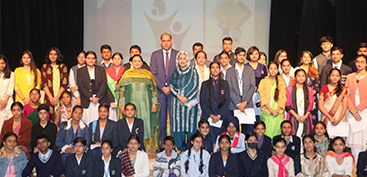Millets like ragi , jowar, bajra and many others are a good alternative to polished rice and processed wheat flour. Famous as millet guru, Ram Babu, 47, a vociferous exponent of inclusion of millets in our diet instead of processed rice and wheat, was at NIFT Mohali to give a live cooking session to students.
While sowing and during their growth, millets do not require any kind of pesticides, unlike rice and wheat. “They just grow like grass, there is no special requirement. Millets are more filling than rice and wheat, so if one kg of rice feeds eight persons, a kg of millets will feed 12 people,” says Ram Babu, while speaking to CityWoofer.
Having learnt all the necessary details while growing up from his maternal grandmother, he says, “Cooking is like meditation for me. Our body organs have developed fully well over centuries and by know, we should know which kind of food suits them”.
When the Green Revolution came in 1960s, wheat and rice were promoted by the governments because companies needed to sell their pesticides. Now, millets sell at very high prices. “Once production of millets starts again, rates will come down,” says Ram Babu giving a ray of hope.
He also stressed that foods change with seasons, millets can be consumed throughout the year but in different forms and compositions.
“Millets are like crawling babies now. They will come full circle in about 50-60 years from now, my aim is to atleast start that process,” he says on an optimistic note.
Lifestyle diseases like diabetes, obesity, fatty liver, high gylcerides, thyroid were never heard of earlier, now there is no dietician who would not recommend millets to get rid of these medical problems.
How do millets help diabetics and obese people?
Millet is lower on the glycemic index (GI) than many other grains. That means it raises your blood sugar slowly and gradually, instead of in quick spikes.
“I never consume white processed foods, white sugar, white salt. I have been working at different levels with farmers, women, so that they can collaborate at different levels to begin the reuse of millets in their daily food again,” says Ram Babu. There are about 1,000 recipes Ram Babu has shared in his books and through his youtube channel which includes millet dosa, muffins, cakes, pastas and what not.
His final message to us? Our food is not only meant to satisfy our taste buds, it builds the relation between Nature and Me, it makes me understand soil, Nature, biodiversity, family welfare, national economy, etc.
2023 as the International Year of Millet (IYOM).
On the initiative of Prime Minister Narendra Modi, the United Nations has declared the year 2023 as the International Year of Millet (IYOM).
The Government of India had notified millets as a nutritious- cereal in April 2018 and millets have also been included in the Poshan Mission campaign.
Under the National Food Security Mission (NFMS), a nutritious cereal component for millets is being implemented in 212 districts of 14 States.
Asia and Africa are the major production and consumption centres of millet crops. India, Niger, Sudan and Nigeria are the major producer of millets.
India is the major production country of millets in which Kangni, Kutki or small millet, Kodon, Gangora or Barnyard, china and Brown top are included along with jowar, bajra, ragi and small millets. Most of the states in India grow one or more millet crop species. During the last 5 years, our country produced more than 13.71 to 18 million tonnes of millet with the highest production in 2020-21.










